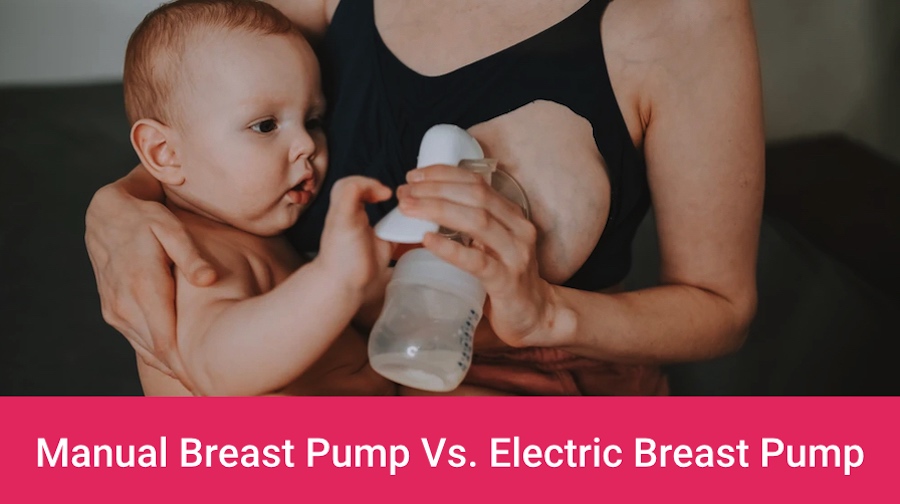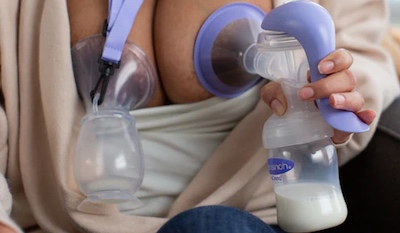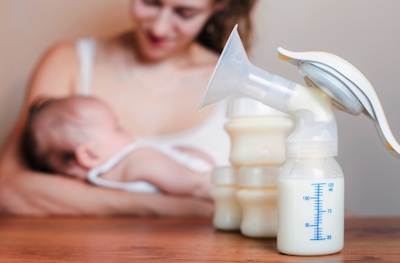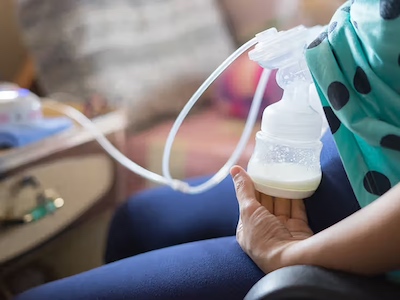
Article By Edna Skopljak – Medical Doctor (MD)
Being a mom is the most precious role – of all. It’s filled with so many happy moments. However, it also comes with a lot of (tough) choices.
New moms usually find the breastfeeding journey especially challenging. For many moms, the decision for breastfeeding is an important one, but so is the choice between manual breast pumps and electric breast pumps, and generally, finding the right breast pump. Now, while not every breastfeeding mom may need a breast pump, it can be a valuable tool for a variety of reasons – obviously, right?
Whether you plan to return to work, share feeding responsibilities with a partner, or simply want to build up a stash of breast milk for later use, using a breast pump (occasionally or regularly) can provide much flexibility and convenience, especially in that first stressful year.
But, before you decide on a breast pump, there are several factors to consider, such as your budget, the frequency of pumping, and your specific needs. For example, if you will be pumping occasionally, or you’re looking for a pump that offers more control, you should probably consider a manual breast pump, which is often less expensive and ideal for occasional use, too.
On the other hand, if you will be pumping regularly – electric breast pump is probably a better option for you. But there are also other things to consider – so make sure you read this article carefully. Let’s help you find the right type of the breast pump for you and your little one!
If you’re a first-time mama or new to pumping, make sure to read my article about breast pumping too.
This post is not a substitute for medical advice or consultation.
Manual Vs. Electric Breast Pumps – Key Differences
If you’re hesitating whether to get a manual or electric breast pump, you need to know the differences between these two first!
1. How It Works
Manual: Manual breast pumps are hand operated, requiring you to manually squeeze a handle or trigger to create suction and express milk from your breast.
Electric: Electric breast pumps are powered by a power source – motor, providing automated suction and milk expression, making them hands-free and convenient.

2. Suction Strength
Manual: The suction strength of a manual breast pump depends on the user’s hand strength, which can be less consistent and may require more effort.
Electric: Electric breast pumps offer adjustable suction settings, generally offering stronger suction and allowing you to fine-tune the intensity to match your comfort level and milk flow, which can be especially useful for moms with varying needs.
3. Efficiency And Speed
Manual: Manual breast pumps are generally slower in milk expression compared to electric pumps, making them more suitable for occasional or on-the-go use in your diaper bag.
Electric: Electric breast pumps are faster and more efficient, making them ideal for frequent pumping or exclusively pumping when time is of the essence.
4. Hands-Free Option
Manual: Manual pumps require one hand to operate the pump and the other hand to hold the breast, making them less hands-free and more time consuming. So, no hands-free option here, and you will have to pump one breast at a time.
Electric: Electric pumps, on the other hand, often come with accessories like hands-free bras or attachments that allow you to pump with both hands-free, providing more flexibility and multitasking opportunities. Plus, you may express breast milk from both breasts simultaneously.

5. Price
Manual: Manual breast pumps are generally more budget-friendly, with affordable prices, making them a cost-effective choice for occasional users or those with limited budget.
Electric: Electric breast pumps tend to be more expensive due to their electric, motorized operation and advanced features, which may be worth the investment for moms who plan to pump frequently or exclusively.
6. Portability And Noise
Manual: Manual pumps are typically more compact, lightweight, and silent, making them an excellent choice for discreet and portable pumping, especially in public or quiet settings.
Electric: Electric pumps are bulkier and may produce noise due to the motor, which can be a consideration if you need to pump in shared or noise-sensitive environments.
7. Maintenance
Manual: As manual pumps have fewer components, they are easier to clean and maintain compared to electric pumps.
Electric: Electric pump has more parts that require regular cleaning and sterilization, which can take more of your time, and may involve additional costs for replacement parts.
8. Power Source
Manual: Manual pumps do not require batteries or a power source, making them dependable and suitable for use anywhere.
Electric: Electric breast pumps rely on power sources, such as electricity, batteries, power cords, or rechargeable batteries, which can limit their use during power outages or in situations where electricity is not readily available.

What Is A Manual Breast Pump?
A manual breast pump is a simple, handheld device designed to assist you in expressing breast milk. Manual pump entirely relies on your manual effort to create suction and extract milk. What’s the science behind the manual pump?
Well, it works by manually squeezing a handle, creating suction, which draws milk from the breasts into a collection container.
Manual pumps are generally chosen by moms who want a portable, cost-effective, and discreet option for occasional pumping. Let’s go over its benefits and drawbacks!
What Are The Advantages Of Using A Manual Breast Pump
Certainly, manual pump may offer so many benefits during your breastfeeding journey. First of all, manual pump is more cost-effective compared to electric model, making them an economical choice for breastfeeding moms.
Furthermore, they are easy to carry around and use on-the-go, which makes them ideal for travel or outings. Plus, they are silent and easy to assemble and use without the need for complex configurations.
Another great advantage of a manual pump is – you have direct control over suction intensity and rhythm, mimicking breastfeeding, which is especially beneficial if you’ve given birth to preterm baby1 or with postpartum complications and long separations of moms and babies2.
Also, with fewer parts to clean and maintain, manual breast pumps are easier to use, clean, and maintain, with less potential for part wear and tear, not requiring electricity or batteries, which makes them reliable in various situations!

Disadvantages Of Manual Breast Pumps
While manual breast pumps have their advantages, they also come with some disadvantages, which may not suit every breastfeeding mom. Note that manual pumps require physical effort, as you must manually operate the handle or lever. This can lead to hand fatigue and may not be sustainable for extended pumping session. However, if you pump occasionally, this shouldn’t be a problem.
Also, manual pumps are generally slower at expressing milk compared to electric pumps, with no hands-free option, taking more of your time. Plus, the suction strength can vary according to your hand strength and rhythm, potentially leading to less efficient milk extraction.
If you use a manual pump, you should also be aware that it’s not the luckiest option for low milk supply, as they are not as effective as electric pumps, and you would require extra stimulation.
What Is Electric Breast Pump
Electric pump is actually a device which uses a motor to create suction for expressing breast milk. You can find so many models out there, but basically, there are two types: plug-in electric pumps, which require a power source, and cordless wearable pumps, which are battery-powered and hands-free.
Electric pumps are great, as they offer adjustable settings, efficiency, and convenience, making them suitable for frequent pumping and various lifestyles. But, they also come with a few drawbacks. Check it all out.

Benefits Of Electric Breast Pump
Electric breast pumps have their benefits, undoubtfully. Its primary benefit is – they are faster and more efficient than manual ones, making them ideal for mothers who need to express larger quantities of milk in less time – with greater milk output.
Having adjustable (hospital-grade) suction strength and speed settings, electric pump allows you to customize the pumping experience for comfortable and effective pumping. And, yes, suction strength is consistent. Some models even have memory settings to remember your preferred pumping rhythm, simplifying future sessions.
Also, some electric pumps are designed for hands-free use, enabling multitasking and convenience during pumping sessions, with the extra option to express milk from both breasts simultaneously, which may save your precious time and increase milk supply – in other words, you can produce more milk3!
But, what is especially great, besides increased milk production, this pump is perfect for moms who are exclusively pumping, or for working mothers, requiring less time and less physical effort. Plus, you have so many models you can choose in between.

Disadvantages Of Electric Breast Pumps
Well, let’s face it – electric breast pumps are generally less affordable than manual ones, which can be a significant upfront investment.
Also, the electric pumps can be quite noisy, potentially causing discomfort or embarrassment for breastfeeding moms when pumping in public, for example.
Note, too, that there are some technical considerations. Like, that electric pumps have more components and require regular cleaning and maintenance, which can be time-consuming.
And, you probably need to pump – plugged in. Plug-in electric pumps require access to an electrical outlet, limiting where and when they can be used. Battery-operated or rechargeable models may require frequent charging or battery replacement.
They may also be bulkier and have a steeper learning curve, which may be more challenging to use and assemble than manual pumps.
Manual Vs. Electric Breast Pump – Which One Is Right For You?
Well, choosing between a manual and electric breast pump depends on your specific needs, lifestyle, and budget.
Generally, manual pump is best for those on a budget, occasional pumpers, or those seeking portability and quiet operation. On the other hand, electric pump is ideal for busy moms, for frequent pumpers, for those wanting to produce more milk, for precise control, and comfort during extended use.
Which Is Less Painful: Manual Or Electric Breast Pump?
This is a difficult question, as the perception of pain during pumping varies individually. The good news is – both manual and electric pumps can be adjusted for comfort.
Some users find manual pumps less painful due to their control, but electric pumps with adjustable settings can be equally comfortable. So, right pump choice in these terms depends entirely on you.

Manual Breast Pumps vs. Electric – FAQ
These information may be too much, and you may still have some uncertainties. That’s why I will provide the answers to some of the frequently asked questions about which – manual or electric pump is better for you.
Is Manual Breast Pump Better Than Electric?
Neither is inherently better. It rather depends on your specific needs and preferences, lifestyle and expectations. Make sure you read the article to find out the benefits and drawbacks of both types, to see which one suits you better.
Do You Get More Milk With A Manual Pump?
Not necessarily. The amount of pumped milk depends on your milk production, schedule, and pumping technique, not merely the type of pump.
Article By Edna Skopljak
Edna Skopljak is Medical Doctor (MD) who works in University Medical Centre in Ljubljana. She’s a She also worked as an editor at BJBMS medical journal for several years. She wrote content for several health-related websites and the BJBMS blog. She’s a mom of a 15-month-old.
The purpose of this article is informative. It’s not a substitute for professional medical advice or medical care. Remember: safety first! Consult your doctor/pediatrician in case of any doubts. The author of this article does not accept any responsibility for any liability, loss or risk, personal or otherwise, incurred as a consequence, directly or indirectly, from any information or advice contained here.
Resources:
https://www.ncbi.nlm.nih.gov/
https://journals.sagepub.com/
Second picture belongs to Lansinoh Brand. Source: https://lansinoh.com/ Fourth picture belongs to Spectra Brand. Source: https://www.spectrababyusa.com/

